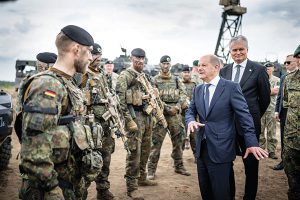Bloomberg
Chancellor Olaf Scholz said Germany is ready to deploy more troops to the Baltics as part of a Nato effort to build up its eastern flank in the face of Russia’s invasion of Ukraine.
Baltic leaders had urgently pushed for an increased troop deployment to mount a stronger defense against a Russian threat — and the German move would set the stage for a decision by the North Atlantic Treaty Organization (Nato) at a summit later this month to expand its forces there.
“We are prepared to strengthen our engagement toward a robust fighting brigade,†Scholz said in Vilnius after a meeting with leaders from Lithuania, Latvia and Estonia.
The three leaders, whom Scholz met on his first Baltic visit since taking office in December, have pressed for an increase to brigade-sized units of as much as 5,000 troops.
Germany leads the Nato contingent in Lithuania, with currently about 1,000 German soldiers on the ground.
“The Baltic states are in a very sensitive security situation on the very front line of Nato,†Lithuanian President
Gitanas Nauseda said alongside Scholz. “Lithuania is prepared to host more allied forces
and to provide the necessary infrastructure.â€
At the June 29-30 Nato summit in Madrid, the 30-member alliance is expected to sign off on plans to reset its long-term defense strategy. Along with bolstering its forces, Nato is expected to preposition more equipment and supplies on its eastern flank.
“In the case of an attack, we will defend every centimeter of Nato territory,†Scholz said, reinforcing the alliance’s Article 5 commitment. He also met Latvian Prime Minister Krisjanis Karins and Estonian Prime Minister Kaja Kallas.
Allies are likely to agree to deploy significant numbers of combat ships and more jets, and to strengthen Nato’s air and missile and cyber defenses. Baltic leaders welcomed the decision by Scholz, who has come under enormous pressure from allies to contribute more to Ukraine’s efforts to beat back Russia.
German lawmakers paved the way for the creation of a debt-financed special fund worth 100 billion euros ($107 billion) for additional military spending, part of a push by the government to transform the armed forces after years of underfunding.
The new investment vehicle, which is not part of the regular budget and not subject to rules limiting net borrowing, will enable Germany to meet a Nato goal of spending 2% of economic output on defense. It comes on top of annual defense spending of some 50 billion euros.
 The Gulf Time Newspaper One of the finest business newspapers in the UAE brought to you by our professional writers and editors.
The Gulf Time Newspaper One of the finest business newspapers in the UAE brought to you by our professional writers and editors.
